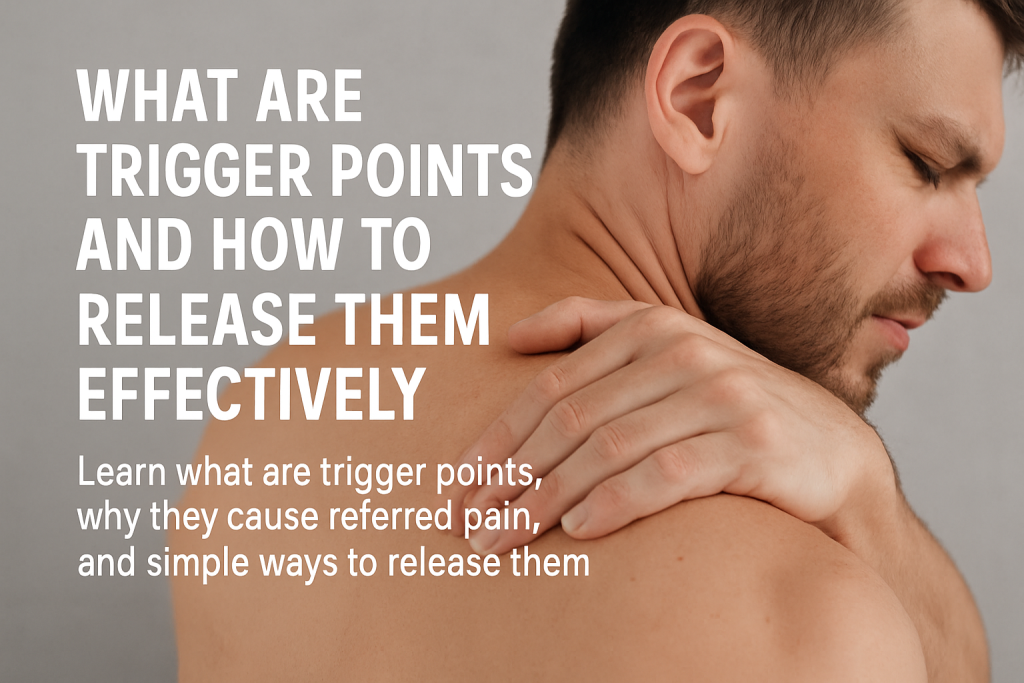Stiff neck after a long drive, aching shoulders by lunchtime, or a nagging low‑back twinge that never entirely disappears—many of these aches begin as tiny bundles of over‑worked muscle fibers called trigger points. To answer what are trigger points, imagine microscopic “tension knots” hidden inside larger muscle bands.
Although they are only millimeters wide, they can radiate pain far from their origin, restrict movement, and even mimic joint or nerve issues. Because their signals confuse the brain, people often treat the wrong area. Fortunately, once you understand how these knots develop, where they hide, and when to treat them, you can cut daily discomfort and keep moving easily.
Tiny Muscle Knots, Big Daily Disruption
At first, a single active trigger point may feel like mild tightness. However, it shortens the surrounding muscle quickly, slows local blood flow, and overloads nearby tendons. Consequently, simple tasks—typing, lifting groceries, or breathing deeply—feel heavier than they should be. Because pain often “refers” along predictable paths, a tension knot in the upper trapezius may throb behind the eye, while one in the glute can shoot into the calf. Moreover, the ache changes with posture and stress, so the source is hard to trace. By mapping these referral patterns early and releasing the knot, you stop the pain cascade before it steals more energy and focus.
How Trigger Points Form and Spread Pain
Trigger points live within the myofascial web—thin connective tissue surrounding every muscle fiber. When that web loses elasticity, the knot tightens, restricts oxygen, and alerts the nervous system. Therefore, nearby fibers brace to protect the area, circulation drops further, and acidic waste builds up. As a result, nerves fire repeatedly, sending sharp or dull pain to distant zones. Although the knot is tiny, the discomfort can cover several inches wide.
Active vs. Latent Trigger Points
- Active points hurt at rest, feel tender to the touch, and create clear referred pain.
- Latent points stay silent until poked, stretched, or tired; yet they weaken the muscle and limit flexibility.
Because latent points often activate during sudden exertion, treating both varieties preserves long-term mobility. Furthermore, early care reduces the chance that a small knot will become a widespread pain pattern.
Posture, Stress, Repetition: Prime Culprits
Daily habits ignite micro‑spasms that grow into trigger points. Below is a quick guide to why common behaviors create knots and, importantly, what to do instead.
| Problem | Why It Creates Knots | Quick Countermove |
| Forward‑head posture | Upper‑back muscles fire nonstop to hold the skull level | Raise laptop, tuck chin gently |
| Emotional stress | Shallow breathing and clenched jaws shorten neck muscles | Use 4‑7‑8 breathing each hour |
| Repetitive micro‑tasks | Constant low-grade load saturates the same fibers | Rotate tasks every 20 minutes |
Even moderate ergonomic tweaks and mindful movement breaks can cut new knot formation by half. Therefore, a small daily investment pays significant comfort dividends.
Safe at‑Home Ways to Release Tight Knots
While professional care is helpful, daily self-care keeps mild tension from escalating.
Here’s how to release trigger points without special gadgets or costly tools.
Foam Rolling & Lacrosse Ball Tactics
- Locate the knot. Glide slowly until tenderness spikes.
- Compress 20–30 seconds. Maintain gentle, tolerable pressure.
- Breathe and move. Roll half an inch side‑to‑side until discomfort drops by about 50 %.
Because rolling blends pressure with slow movement, it shifts fluid, lowers acidity, and softens stubborn fibers. Consequently, the muscle relaxes and blood flow returns.
Stretch + Heat Pairing for Faster Relief
First, apply a warm pack for five minutes to soften fascia. Then follow with a slow static stretch—holding thirty seconds—until you feel length rather than pain. Because heat boosts circulation, the knot receives oxygen sooner and releases faster. Moreover, stretching after heat helps reset muscle length, so tightness stays away longer.
Take‑Home Tip: Alternate rolling in the morning with heat‑and‑stretch at night. Many users note a 30 % drop in next-day stiffness after one week of this simple rhythm.
Simple Self-Care Checklist
- Drink water—hydration keeps fascia supple.
- Move hourly—a quick shoulder roll or hip hinge breaks static load.
- Sleep smart—support the neck with a medium-firm pillow to avoid overnight cramping.
Because consistent routine outweighs occasional effort, embedding these habits into daily life offers steady protection against new trigger points.
When to Call Trigger Point Therapists in San Diego
Home methods work well for early knots; however, persistent pain that lasts beyond two weeks, limits function, or causes numbness suggests layered dysfunction. Certified trigger point therapists San Diego CA, assess whole‑body mechanics, locate overlapping knots, and apply evidence-based techniques—ischemic compression, gentle myofascial strokes, or dry needling—tailored to your needs. Moreover, they guide ergonomic corrections and exercise progressions so new knots stop forming. Therefore, professional sessions complement self-care and accelerate recovery.
What a Session at Chill Spa Looks Like
During your first visit, the therapist will:
- Review health history, lifestyle, and movement goals.
- Map active and latent knots through gentle palpation.
- Apply sustained pressure for thirty‑to‑ninety seconds per point, pausing for slow, controlled breaths.
- Reassess range of motion, then teach one personalized stretch to maintain gains.
Because each treatment blends science and body awareness, most people feel lighter, breathe deeper, and move more freely right after the session. You will also receive a direct link to the trigger point therapy resource page for guided follow-ups and easy online booking. Ready to move without hidden aches? Call or visit Chill Spa. Consistent care, clear guidance, and calm surroundings await—so you can breathe, stretch, and smile comfortably every day.

